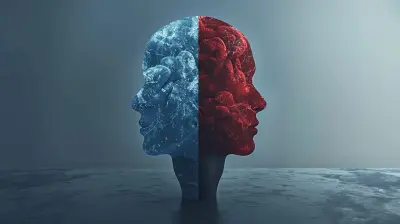Using Technology to Enhance Critical Thinking in the Classroom
6 May 2025
Introduction
In today’s fast-paced digital world, education is evolving at lightning speed. Gone are the days of rote memorization and passive learning. Instead, critical thinking has taken center stage, shaping how students analyze, evaluate, and solve problems. But here’s the real game-changer—technology. When used effectively, technology can supercharge critical thinking, making learning more engaging, interactive, and thought-provoking.
But how exactly does technology help in building these essential skills? Let’s dive deep into how educators can harness digital tools to foster critical thinking in the classroom. 
What Is Critical Thinking, and Why Is It Important?
Critical thinking is more than just thinking hard—it's about thinking smart. It involves analyzing information, questioning assumptions, recognizing biases, and making logical decisions. In short, it’s the ability to think clearly and rationally while understanding the connections between ideas.Why is critical thinking important? Because the world is full of information—some of it useful, some of it misleading. Without strong critical thinking skills, students may struggle to differentiate facts from opinions or fall for misinformation. Plus, employers value critical thinkers who can solve complex problems, adapt to challenges, and make informed decisions.
Technology, when used correctly, can be a powerful tool to sharpen these skills. Let’s look at some practical ways digital tools can help. 
How Technology Enhances Critical Thinking in the Classroom
1. Encourages Inquiry-Based Learning
Inquiry-based learning flips the traditional teaching model on its head. Instead of simply absorbing information, students actively ask questions, investigate problems, and find solutions.With technology, students can access vast amounts of information quickly. Platforms like Google Scholar, online databases, and educational websites allow students to research topics in depth. They’re no longer limited to textbooks—they have the entire internet at their fingertips. But this is where critical thinking comes in: they must learn to evaluate sources, distinguish credible information from unreliable ones, and form well-supported arguments.
Example: A history teacher might assign students to research a historical event using multiple online sources. The students must cross-check facts, analyze different perspectives, and present a balanced view of what really happened.
2. Develops Problem-Solving Skills Through Gamification
Who said learning has to be boring? Educational games not only make learning fun but also challenge students to think critically and solve problems creatively.Games like Minecraft: Education Edition, Kahoot!, and BrainPOP create immersive learning experiences requiring students to strategize, analyze scenarios, and make decisions. Puzzle-based games in math, science, and even language arts encourage students to experiment with solutions, fail, and try again—an essential aspect of critical thinking.
Example: In a math class, students can use a game where they must quickly analyze data, detect patterns, and apply mathematical reasoning to progress through levels. This keeps them engaged while sharpening problem-solving skills in a real-world context.
3. Encourages Collaboration and Debate
Collaboration is a cornerstone of critical thinking. When students work together, they are exposed to different viewpoints, compelling them to analyze, debate, and refine their own arguments.Technology-powered collaboration tools like Google Docs, Padlet, and Microsoft Teams allow students to brainstorm and work on projects simultaneously, no matter where they are. Virtual discussions and debates using platforms like Flipgrid or discussion boards challenge students to articulate their thoughts and defend their opinions with logic and evidence.
Example: In an English class, students might engage in an online debate about a controversial issue. They research both sides of the argument using digital sources and present well-formed responses, improving their critical thinking in the process.
4. Promotes Self-Paced and Personalized Learning
Every student learns differently. Some grasp concepts quickly, while others need more time to absorb information. With technology, teachers can offer personalized learning experiences, helping students develop critical thinking at their own pace.Adaptive learning platforms, such as Khan Academy, Duolingo, and Coursera, adjust content based on a student's strengths and weaknesses. This keeps learners challenged without overwhelming them. Instead of passively receiving information, students take charge of their learning, setting goals, troubleshooting difficulties, and applying acquired knowledge.
Example: A struggling math student may receive extra practice problems automatically, while a more advanced student might get challenging application-based problems, ensuring both thrive at their own level.
5. Introduces Real-World Problem Solving with Simulations
Technology allows students to apply critical thinking to real-world scenarios through virtual simulations and interactive case studies.Virtual labs in science classes let students experiment without the constraints of physical materials. Business simulation games teach students to make strategic financial decisions. Coding platforms like Scratch and Python introduce problem-solving using logical sequencing and debugging.
Example: A group of students interested in environmental science might use a climate change simulation tool to predict the impact of deforestation over time, forcing them to analyze data, interpret trends, and propose solutions. 
Challenges of Using Technology for Critical Thinking
While technology is a powerful tool, it’s not a magic wand. There are challenges educators must navigate when integrating it into critical thinking lessons.1. Digital Distractions
Let’s be real—students are easily distracted by social media, online games, and endless YouTube videos. If technology isn’t used with clear goals, it can become more of a distraction than a learning aid.2. Access and Equity Issues
Not all students have equal access to technology. Some may lack reliable internet or devices at home, making it difficult to fully participate in digital learning.3. Information Overload
With so much information available, students may struggle to filter out relevant content. Without proper guidance, they might fall victim to misinformation or biased sources.4. Teacher Readiness and Training
For technology to be effective, teachers need proper training. Simply handing students a tablet won’t automatically boost critical thinking. Educators must know how to integrate tech tools in meaningful ways.
Best Practices for Using Technology to Foster Critical Thinking
To overcome these challenges, educators must be intentional in how they use technology. Here are some simple strategies to make sure tech enhances rather than hinders learning:✔ Set Clear Learning Objectives: Make sure digital tools align with clear critical thinking goals. Just using technology isn’t enough—it must serve a defined educational purpose.
✔ Encourage Reflection: Have students reflect on their thought processes. Ask questions like, “How did you arrive at this conclusion?” or “What evidence supports your answer?”
✔ Teach Digital Literacy: Help students evaluate the credibility of online sources. Teach them how to fact-check, recognize bias, and differentiate between reliable and misleading information.
✔ Use a Blended Approach: Technology should complement, not replace, traditional learning methods. A mix of face-to-face discussions and digital tools creates a well-rounded learning experience.
✔ Foster a Growth Mindset: Show students that struggling with tech-based challenges is part of the learning process. Encourage them to persist, experiment, and find creative solutions.
Conclusion
Technology, when used wisely, is a powerful ally in developing critical thinking skills. From gamification and collaboration tools to simulations and personalized learning, digital resources bring education to life, transforming the way students approach problem-solving.However, technology alone won’t create critical thinkers—it’s how educators integrate it into learning that makes all the difference. By balancing digital tools with thoughtful teaching strategies, we can empower students to ask questions, analyze information critically, and become lifelong problem solvers.
After all, the ultimate goal of education isn’t just to teach students what to think—it’s to teach them how to think.
all images in this post were generated using AI tools
Category:
Critical ThinkingAuthor:

Madeleine Newton
Discussion
rate this article
5 comments
Clover Ellison
Great insights! Embracing technology in the classroom can really boost critical thinking skills. It’s exciting to see how digital tools can empower students to analyze, evaluate, and create in new ways. Keep up the fantastic work!
May 21, 2025 at 3:20 AM

Madeleine Newton
Thank you for your kind words! I completely agree—technology can truly transform the learning experience.
Icarus Sharpe
Empower minds through technology's limitless potential!
May 19, 2025 at 3:57 AM

Madeleine Newton
Absolutely! Technology opens doors to innovative tools and resources that foster critical thinking and creativity in the classroom.
Ashley Baxter
Great insights! Technology truly empowers students to enhance their critical thinking skills.
May 10, 2025 at 4:15 AM

Madeleine Newton
Thank you! I'm glad you found the insights valuable. Technology indeed plays a pivotal role in fostering critical thinking among students.
Julian Lopez
This article effectively highlights how integrating technology fosters critical thinking skills in students. By utilizing interactive tools and resources, educators can create engaging learning experiences that enhance analytical abilities and problem-solving techniques.
May 7, 2025 at 3:02 AM

Madeleine Newton
Thank you for your insightful comment! I appreciate your recognition of how technology can transform learning and promote critical thinking in students.
Damian McConkey
This article effectively highlights the importance of incorporating technology in education to foster critical thinking skills. By leveraging innovative tools and techniques, educators can create dynamic learning environments that encourage deeper analysis, problem-solving, and collaboration among students. Great insights!
May 6, 2025 at 11:26 AM

Madeleine Newton
Thank you for your thoughtful feedback! I'm glad you found the insights on leveraging technology to enhance critical thinking valuable.




